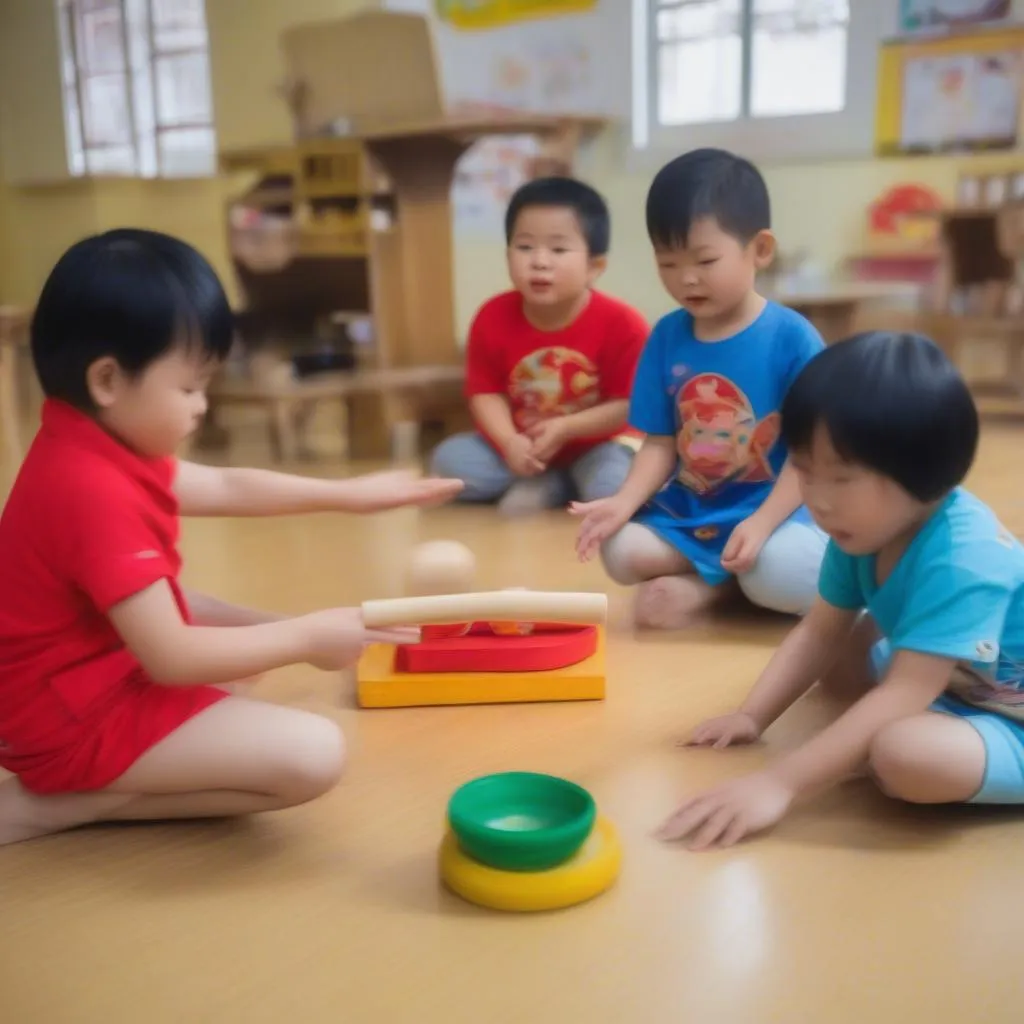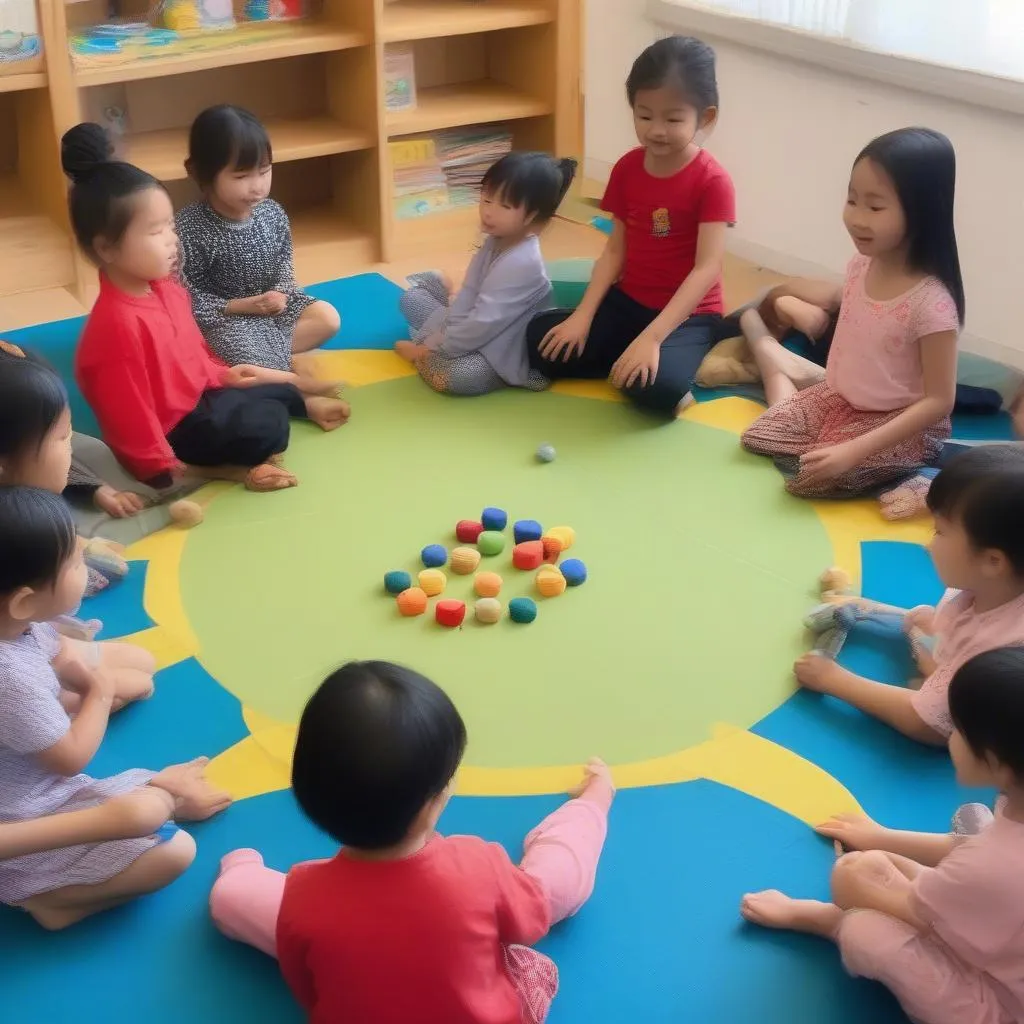“Honey, do you know any folk games? Which one is the most fun?” – Grandma’s question made Minh pause. Minh is only familiar with video games on tablets and knows nothing about folk games. Grandma smiled gently, “Back in the day, Grandma was just like you, only interested in video games. But later, I realized how interesting and beneficial folk games are! They not only helped Grandma train her health and intelligence but also helped her understand more about our national culture.”
Folk Games – A Priceless Cultural Treasure for Preschoolers
Folk games are an indispensable part of Vietnamese culture. For generations, they have become a familiar spiritual food for generations, contributing to educating and nurturing children’s souls. According to Mr. Nguyen Van A, a preschool education expert, in the book “Vietnamese Folk Games”, “Folk games are an effective educational method, helping children develop comprehensively in terms of physical, intellectual, emotional, social, and aesthetic aspects.”
Amazing Benefits of Folk Games for Preschoolers
- Physical Development: Folk games like “hide-and-seek”, “jump rope”, and “tug of war” help children practice movement skills, improve health, and enhance physical fitness.
- Intellectual Development: Games like “O An Quan”, “Chinese Chess”, and “Chess” require children to reason logically, calculate, and train their thinking and creativity skills.
- Emotional and Social Development: Games like “hide-and-seek”, “mimicking”, and “animal sounds” help children learn how to communicate, cooperate, share, and practice social skills.
- Aesthetic Development: Games like “kéo quân”, “danh chuyen”, and “nhảy sạp” help children train dexterity, rhythm, and aesthetic perception.
Some Popular Folk Games for Preschoolers
1. “Chase” (Đuổi Bắt) Game
Description: This game is very simple. One person is the “catcher”, and the rest are “runners”. The “catcher” has to chase the “runners” and touch them to make them the “catcher”.
Instructions:
- Choose one person to be the “catcher”.
- The rest are “runners”.
- The “catcher” must chase the “runners” and touch them to make them the “catcher”.
- The “catcher” should not run too fast, giving the “runners” a chance to escape.
Benefits: Trains running speed, quick reflexes, and improves health.
2. “Tug of War” (Kéo Co) Game
Description: This game is divided into two teams. Each team holds one end of a rope. The two teams pull the rope towards themselves. The team that pulls the rope to their side first wins.
Instructions:
- Divide into two teams with an equal number of people.
- Two teams hold one end of a rope.
- The two teams pull the rope towards themselves. The team that pulls the rope to their side first wins.
Benefits: Trains strength, coordination, and teamwork spirit.
3. “O An Quan” Game
Description: This game is played on a board with 12 squares, each square containing seeds. Players take turns moving the seeds according to certain rules to eat all of the opponent’s seeds.
Instructions:
- Each player has 6 squares and 6 seeds.
- Move the seeds according to certain rules to eat all of the opponent’s seeds.
- The player who eats all of the opponent’s seeds first wins.
Benefits: Trains logical thinking, calculation skills, and strategic skills.
4. “Hide-and-Seek” (Trốn Tìm) Game
Description: This game is played with many people. One person is the “seeker”, and the rest are “hiders”. The “seeker” must find the “hiders” and count the number of “hiders” found.
Instructions:
- Choose one person to be the “seeker”.
- The rest are “hiders”.
- The “seeker” must find the “hiders” and count the number of “hiders” found.
- The “hiders” must find a hiding place that is really discreet so that the “seeker” cannot find them.
Benefits: Trains agility, observation skills, searching ability, dexterity, and adaptability.
5. “Mimicking” (Bắt Chước) Game
Description: This game is played with many people. One person is the “leader”, and the rest are “players”. The “leader” will perform an action, and the “players” must mimic that action.
Instructions:
- Choose one person to be the “leader”.
- The rest are “players”.
- The “leader” will perform an action, and the “players” must mimic that action.
- The “leader” can change actions at any time to add excitement to the game.
Benefits: Trains observation skills, memory skills, agility, reflexes, and expression skills.
Notes When Organizing Folk Games for Preschoolers
- Choose games suitable for children’s age: Avoid choosing games that are too difficult or too easy, and avoid choosing games that may be dangerous for children.
- Prepare sufficient tools: Before playing, it is necessary to prepare enough tools for the game, such as ropes, balls, board games, etc.
- Explain the rules clearly: It is necessary to explain the rules of the game clearly to children so that they understand how to play and follow the rules correctly.
- Create a fun and comfortable atmosphere: A fun and comfortable atmosphere should be created so that children can have fun and learn freely.
- End the game gently: The game should be ended gently to avoid children being surprised or hurt.
“Bamboo is the tree of Vietnamese people” – Poem by poet Xuan Quynh – is an affirmation of the familiarity of folk games with Vietnamese culture. Folk games are not only spiritual food for children but also a bridge between generations, helping Vietnamese culture to be transmitted and promoted in the modern era.
 Preschoolers happily playing folk games
Preschoolers happily playing folk games
 Tug of war game for preschoolers
Tug of war game for preschoolers
 O An Quan game for preschoolers
O An Quan game for preschoolers
Frequently Asked Questions about Folk Games for Preschoolers
- “How to make preschoolers interested in folk games?”
To make preschoolers interested in folk games, you can:
- Introduce children to folk games they don’t know yet.
- Teach children how to play games clearly and easily.
- Create a fun and comfortable atmosphere for children when playing.
- Encourage children to participate in games and create healthy competition.
- “Are there any folk games suitable for preschoolers under 3 years old?”
There are many folk games suitable for preschoolers under 3 years old, such as “chase”, “jump rope”, “hide-and-seek”, “mimicking”, etc. However, you should choose games with simple rules, not too complicated for children to understand and participate in.
- “Should modern toys be used when playing folk games for preschoolers?”
Modern toys can be used when playing folk games for preschoolers to increase the attractiveness of the game. However, safe toys that are suitable for children’s ages should be chosen.
Conclusion
Folk games are an indispensable part of preschool education. Give children the opportunity to experience and learn about these meaningful games. Let Vietnamese culture be passed down through generations of children and contribute to helping children develop comprehensively.
Please contact us via phone number 0372999999 or come to address 234 Hao Nam, Hanoi for free consultation on folk games suitable for preschoolers.
You can also refer to some other articles on the website “TUOI THO”: